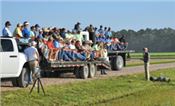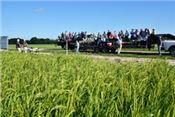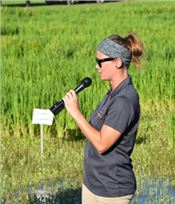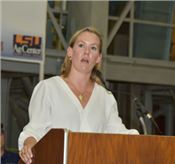|
Free Trade Agreement Generates Funds For LSU AgCenter Rice Research

LSU AgCenter plant pathologist Don Groth, far right, talks about ways of preventing fungicide resistance at the June 27 field day at the LSU AgCenter H. Rouse Caffey Rice Research Station.
Photo by Bruce Schultz/LSU AgCenter
CROWLEY, LA.
Funds resulting from the Colombian Free Trade Agreement have paid for long-term improvements at the LSU AgCenter H. Rouse Caffey Rice Research Station as well as funding a $1 million endowed chair for rice research in the LSU AgCenter, said Jackie Loewer, president of the Louisiana Rice Research Board.
Last year, the Colombian funds generated $1.8 million for Louisiana rice research, and the trade agreement allowed U.S. rice to be sold in Colombia duty-free, Loewer said at the annual AgCenter rice field day at the research station on June 20.
Loewer presented a check for $1.5 million from farmer checkoff funds used for rice research to Bill Richardson, LSU vice president for agriculture. Don Groth, resident coordinator of the Rice Research Station, said the checkoff funds paid by farmers is crucial to work conducted at the station.
Speaking to roughly 350 people attending the field day, the regional director of the U.S. Environmental Protection Agency said that the agency has become more user-friendly.
“This is a new day at the EPA,” said Anne Idsal, director of EPA Region 6, which includes Louisiana, Texas, Arkansas, Oklahoma and New Mexico. She said reduced time frames can be achieved by eliminating duplication during the review process.
The EPA is focusing on problem-solving, and that requires input. “We need to provide better customer service,” she said. “You are our customers.”
The EPA is now geared toward working with states to achieve compliance with regulations, and different areas of the country require different solutions. “I don’t presume to know the ins and outs of every parish,” Idsal said.
The EPA has helped make significant environmental improvements, she said. “Over time, we have driven our ozone levels down 25 percent across the country.”
Action by the state legislature in the recent special session has prevented cuts to the LSU AgCenter. “We’re far from fully funded,” Richardson said.
A “64 Strong” campaign is underway to get an agriculture scholarship for a student in each Louisiana parish, and so far 43 scholarships have been secured. “We are committed to getting the best students in the state into agriculture,” Richardson said.
The Louisiana Rice Research Board’s funding of long-term research projects has paid off, said Rogers Leonard, LSU AgCenter associate vice president. “We have the best research center for rice in the United States,” he said.
Land-grant universities such as LSU will be cooperating more in a national effort to release new rice varieties, Leonard said.
During the field tour, AgCenter plant pathologist Don Groth said avoiding fungicide resistance requires following four steps.
First, don’t reduce fungicide rates. “If you cut the rates, it’s like not taking all your antibiotics,” he said.
Second, rotate different fungicides to change the modes of action.
Third, application at the best time is important. Fungicides sprayed too late are less effective on a larger disease population, and that increases resistance possibilities, he said.
Finally, use fungicides only when they are needed, he said.
AgCenter weed scientist Eric Webster said Provisia rice showed injury when it was sprayed with the Provisia herbicide, but that was expected.
The new herbicide Gambit has been effective, but it could delay maturity by one to three days if it is applied after weeds have become established, he said.
The herbicide Loyant has resulted in crop injury, especially when it is applied on dry ground and a crop is already under stress. He said hybrids are showing more injury than varieties.
AgCenter entomologist Blake Wilson said a new seed-treatment product, Fortenza, is showing good results against rice water weevils, but it has not received approval to be used in rice.It is similar to Dermacor, but it is not as effective against stem borers.
Another product, Tenchu, may be a good for stink bug control in rice fields near crawfish ponds.
Wilson also advised farmers about the channel apple snail, an invasive species that has caused problems for some crawfish producers.
Emily Kraus, an entomology graduate student, said she has been studying the use of jasmonic acid as a seed treatment for rice water weevil protection. It is showing effectiveness, but it delays germination and heading.
A study of resistant traits in varieties is being conducted to help breeders develop varieties with insect resistance, she said.
AgCenter rice breeder Adam Famoso said a new line of Provisia, PVL108, could be released in 2020.
A new Clearfield line of a Jasmine-type variety, CLJ01, was released this year, and it has the lowest amount of chalk than any variety.
The medium-grain variety CL272 has been tested favorably by Kellogg, and the next step is a 30-day plant run. “Kellogg will be the big determinant on how well 272 takes off,” Famoso said.
Xueyan Sha, a former AgCenter rice breeder now at the University of Arkansas, said the medium-grain variety Titan also is being tested by Kellogg.
AgCenter hybrid rice breeder Jim Oard said a partner is being sought to produce the AgCenter hybrid LAH169, released this year. Seed for commercial production could be available in two to three years.
The hybrid has yield potential equal to the most popular commercial hybrids grown in Louisiana. Also, LAH169 has lower grain chalk than commercial hybrids grown in the state, he said.
Hybrid lines with the Clearfield and Provisia traits also are in development.
AgCenter rice specialist Dustin Harrell said his work has included new technology such as furrow irrigation rice used in northeast Louisiana. The system requires the disease resistance of a hybrid, and weed control is a challenge. But, he said, the biggest hurdle is nitrogen fertilizer management.
Harrell also said his project is using drones carrying sensors to determine midseason nitrogen needs.
Jimmy Flanagan, LSU AgCenter agent in St. Mary Parish, said fixed-wing drones can cover more area, but battery time is a limiting factor. And AgCenter agricultural engineer Randy Price said drones are ideal for areas that present challenges for aerial pesticide applications. ∆

Participants at the LSU AgCenter H. Rouse Caffey Rice Research Station field day on
June 27 listen to presenters talk about using drones in agriculture.

Emily Kraus, an entomology graduate student, talks about research being conducted on insect
control in rice at the June 27 field day at the LSU AgCenter H. Rouse Caffey Rice Research Station.

Anne Idsal, regional director for the U.S. Environmental Protection Agency, was the keynote speaker at the annual LSU AgCenter H. Rouse
Caffey Rice Research Station field day on June 27.
Photos by Bruce Schultz/LSU AgCenter
|
|